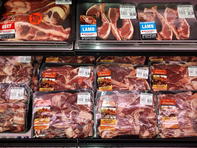Local cultural demand for the use of goats in South Africa is currently driving (and exceeding) the supply of live goats. Goats for meat are mainly marketed in the informal sector, in the Eastern Cape and KwaZulu-Natal, which is driving the goat industry.

The informal live market pays higher prices than the formal mutton and goat abattoirs can offer (e.g. R1 200 vs R700 for the same size/age animal - Nov 2018). The informal goat meat market in South Africa is mostly supplied by (live) indigenous goats as well as some older Angora goats (seasonal).
Commercial Availability of Goat Meat
Surveys by the South African Meat Industry Company (SAMIC) have shown that goats slaughtered in the commercial sector are mainly Boer goats and surplus Angora goats which make up about 0.55% of the goats slaughtered commercially.
However, some other observers put the commercial slaughter figure of goats at 5%. From 2018, all goat carcasses slaughtered in commercial abattoirs should be roller marked in orange and blue. The blue mark is only used for kids (young goats) while the orange mark is used for all goat carcasses, irrespective of age.
The Boer Goat Breeders Association feels this new roller mark would help boost the commercial consumption of goat meat in South Africa. During 2018 a project was launched to test the marketing and commercial sale of Angora meat products in a group of retail stores in the Eastern Cape.
The project was not commercially viable due to the seasonal availability of slaughter-age Angora goats. This seasonality causes inconsistent availability. In addition, it appeared that consumers still preferred more expensive (+R10 - R20/kg) lamb or mutton than to goat meat.
Yet, some producers have commented (November 2018) that meat inspectors do not always know how to classify goat carcasses. Western Cape Boer goat producer Pip Nieuwoudt states that there is a growth in the demand for goat meat due to the health benefits of the meat, but due to the good price goats fetch in the informal sector there is an undersupply to restaurants and shops.
Developing the Goat Meat Market
Further development of the communal goat farming sector is needed and the Red meat Producer’s Organisation (RPO), breeding associations and governmental departments of agriculture are in an ideal situation to assist with this.
That was the sentiment of the meat goat working group chaired by Dr Pieter Prinsloo. Other areas of the meat goat farming industry that needs attention are the proper marketing of goat meat, consumer education as well as research and development.
Most producers believe that the biggest challenge and indeed, crucial to the development of the goat meat sector, is improved governmental policy.
Meat Goat Working Group
In 2016, the Red Meat Research & Development SA (RMRD-SA) called together a working group to work on a development program for the meat goat industry.
The working group consisted of meat goat breeding associations, provincial departments of agriculture, the SA Mohair Cluster, the Informal Goat Industry Cluster, the Agricultural Research Council (ARC) and the South African Meat Industry (Samic).
During a meeting in June 2018, this working group under the leadership of Dr Pieter Prinsloo made recommendations, that specifically includes the marketing of goat meat, more research and consumer education. The workgroup felt that the informal sector is the main source of income for the meat goat industry, but there remains scope to further develop niche markets.
By Marinda Louw